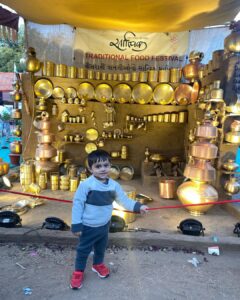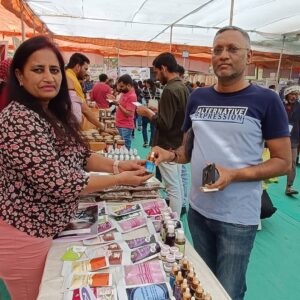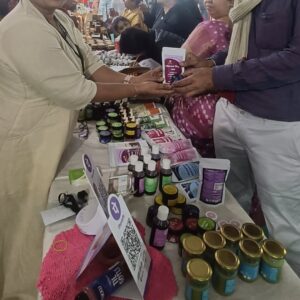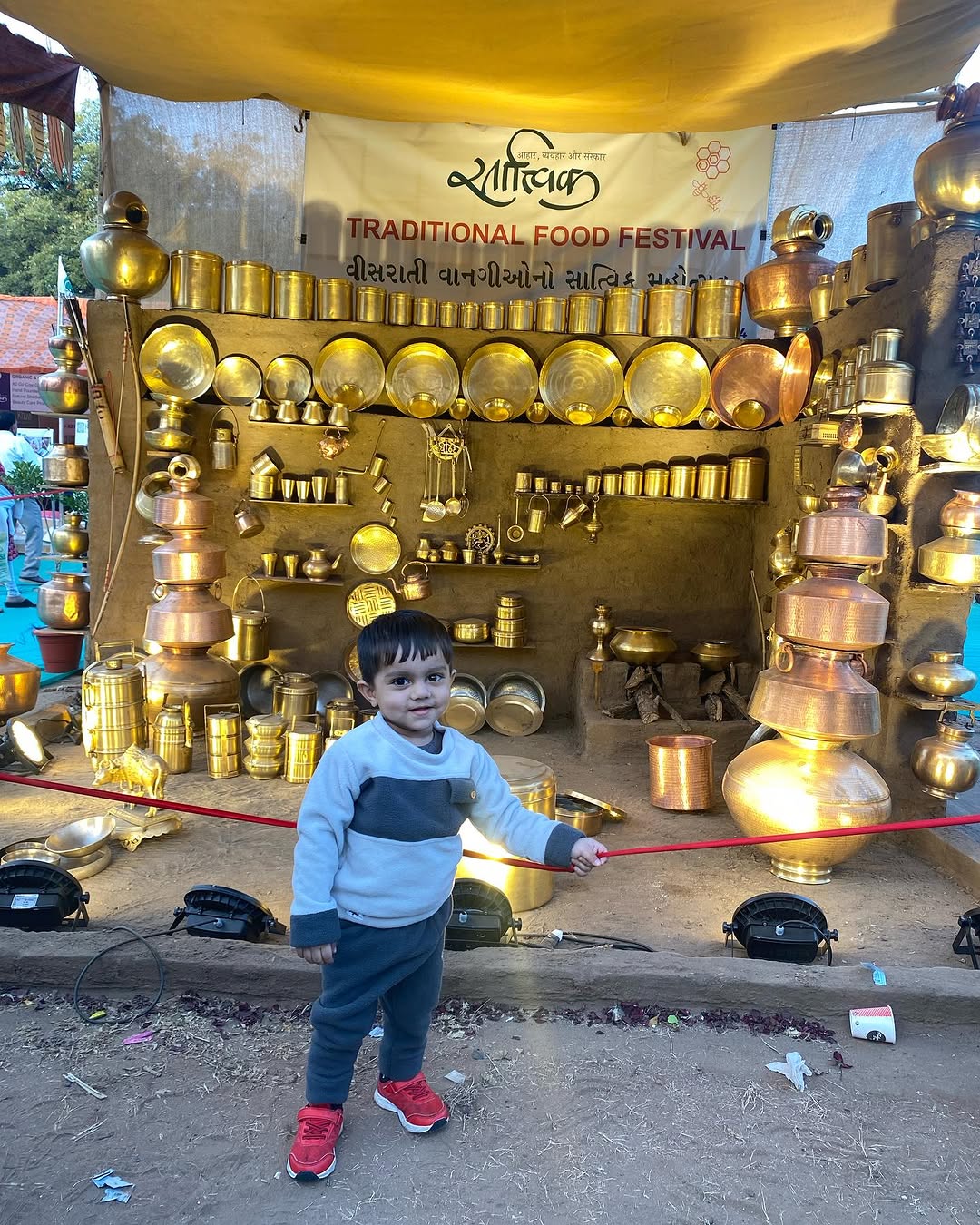Article written by: Danisha R Tank
JOURNALISM STUDENT [ MDC ] , GUJARAT UNIVERSITY
Synopsis: This article highlights the 22nd Sattvik Food Festival 2024 celebrating India’s culinary heritage and sustainable living through traditional food. organic farming and environmentally friendly practices. The role of festivals in tackling climate change and promoting mindful consumption is highlighted.
“Sattvik Traditional Food Festival 2024: Reviving India’s Culinary Heritage and Promoting Sustainable Living”
Ahmedabad witnessed a vibrant confluence of tradition, sustainability, and culinary excellence at the 22nd Sattvik Traditional Food Festival, held from December 28 to 31, 2024, at Shree Bhagwat Vidyapith, Sola. Organized by SRISTI (Society for Research and Initiatives for Sustainable Technologies and Institutions), the festival continued its legacy of promoting agro-biodiversity, healthful eating, and cultural heritage, drawing visitors from across India. 
The Roots of the Sattvik Festival
The Sattvik Traditional Food Festival was initiated over two decades ago by the Honey Bee Network and SRISTI to create awareness about lesser-known, nutritious crops and traditional knowledge systems. Prof. Anil Gupta, the founder of the Honey Bee Network, explains, “The idea began as a promotion of traditional nutritious food and knowledge systems. Over the years, it has brought attention to vanishing delicacies, encouraging their revival.
The focus is on “Sattvik” food that is pure, vegetarian and natural. This festival is in line with the principles of Ayurveda. which emphasizes harmony between food and health. The festival provides market-based incentives to preserve agricultural biodiversity. Promote a sustainable ecosystem where traditional knowledge meets the needs of modern consumers and it plays an important role in revitalizing foods that have been forgotten for many years. and promote sustainable agricultural practices. By connecting farmers, housewives, and entrepreneurs with urban consumers. This work has grown into a movement that connects rural traditions with modern lifestyles.
Millets and Vanishing Delicacies Take Centre Stage
This year’s festival had a special emphasis on millets and disappearing delicacies. Prof. Anil Gupta, founder of the Honey Bee Network, explained that Sattvik started as a platform to promote traditional nutritious food and knowledge systems. “Over the years, we’ve created consciousness approximately lesser-regarded cuisine. This year, we’ve delivered members from various areas of India, imparting dishes like nadru yakhni (lotus roots in yogurt) from Jammu & Kashmir and thukpas from Sikkim,” he said. Chetan Patel, coordinator of SRISTI, highlighted the variety of the competition: “With 250-bizarre stalls, such as 70 devoted to nearby cuisines, we ensured that almost all featured at the least one or two millet-based totally cuisine. This recognition objectives to raise awareness approximately the dietary and ecological advantages of these grains.”
Highlights of the 22nd Edition [ Ahmedabad 2024] 
1. Khedut Haat (Farmers’ Market): The Farmers’ Market provided a direct platform for organic farmers to connect with consumers. Key offerings included:
- Millets and Grains: Bajra, jowar, ragi, and kodra.
- Organic Spices and Pulses: Locally grown turmeric, black gram, and masoor dal.
- Traditional Oils: Cold-pressed sesame and mustard oils.
- Fresh Produce: Seasonal vegetables cultivated without chemical fertilizers.
This interaction underscored the importance of supporting local, sustainable agriculture. This thoughtfully curated marketplace provided a unique platform for organic farmers to directly connect with consumers, fostering an environment of trust and transparency in the food supply chain. The Khedut Haat was not just a marketplace but a microcosm of sustainable living. It reinforced the importance of bridging the gap between those who grow food and those who consume it, fostering a shared commitment to eco-friendly and health-conscious choices. Through this initiative, the Sattvik Festival exemplified how traditional wisdom can pave the way for a more sustainable future in agriculture.
2. Traditional Recipe Competition
Participants showcased unique recipes featuring heritage ingredients like samo (Echinocloa colonum) and bajra (Pennisetum glaucum). Dishes such as bajra khichdi, methi thepla, and gud papdi highlighted the nutritional value and versatility of traditional grains demonstrated how these heritage ingredients, rich in fibre and essential nutrients, can address modern health challenges. Participants shared stories of intergenerational knowledge, blending tradition with innovation, while promoting sustainable and healthy eating practices. This event underscored the importance of conserving agro-biodiversity and reconnecting with our roots through food.
3. Workshop and Expert Talks: The festival hosted workshops led by nutritionists and chefs, focusing on:
- Millet-Based Cooking: Easy ways to incorporate millets into daily meals.
- Sustainability in the Kitchen: Tips for reducing waste and using biodegradable materials.
- Herbal Benefits: Incorporating Ayurvedic herbs for enhanced immunity.
Expert speakers discussed how millets can combat malnutrition and climate change, aligning with the UN’s declaration of 2023 as the International Year of Millets. The 22nd Sattvik Traditional Food Festival featured enriching workshops and expert talks, spotlighting millet-based cooking, kitchen sustainability, and the benefits of Ayurvedic herbs. Nutritionists and chefs shared practical tips for incorporating millets into daily meals and reducing waste with biodegradable materials. Experts emphasized Ayurveda’s holistic approach, demonstrating how herbs can boost immunity and overall health. These sessions bridged traditional knowledge with modern dietary needs, inspiring attendees to adopt sustainable and nutritious lifestyle practices.
4. Grassroots Innovations & Exhibitions 
The 22nd Sattvik Traditional Food Festival showcased a dedicated section for grassroots innovations and sustainable farming technologies, drawing significant interest from attendees. This segment aimed to bridge traditional practices with modern solutions, promoting sustainability at every level of the food chain.
Eco-Friendly Food Packaging: Innovative biodegradable packaging solutions, made from natural fibres and plant-based materials, were displayed as alternatives to plastic, reducing environmental impact and supporting sustainable consumption.
Solar-Powered Cooking Tools: Cutting-edge solar cookers and dryers demonstrated energy-efficient ways to prepare and preserve food, emphasizing renewable energy’s potential in reducing carbon footprints.
Community-Driven Seed Banks: Exhibitors highlighted the importance of conserving indigenous seed varieties. These community-managed seed banks preserve agro-biodiversity, ensure food security, and empower local farmers by reducing dependency on commercial seed suppliers.
This exhibition underscored the synergy between grassroots creativity and sustainable practices, offering practical solutions to modern environmental challenges while celebrating traditional wisdom.
5.Interactive Zone for Children: Educational activities for children included:
Food Art: Young participants explored their artistic side by crafting creative designs using millet flour, learning about the importance of millets in a fun and hands-on way.
Cooking Challenges: Budding chefs were encouraged to prepare simple and healthy recipes, fostering an appreciation for nutritious ingredients and the joy of cooking.
Food History Trivia: Interactive quizzes introduced children to the fascinating origins of traditional Indian dishes, combining education with entertainment to inspire a deeper connection to their cultural heritage.
Sustainability at the Core
The Sattvik Traditional Food Festival 2024 showcased its unwavering commitment to sustainability through a series of eco-friendly initiatives designed to minimize environmental impact.
- Biodegradable Plates and Cutlery: All food was served on plates and with cutlery made from biodegradable materials, effectively reducing plastic waste and setting a precedent for sustainable event practices.
- Composting Leftovers: The festival implemented a zero-food-waste policy, collecting leftover food and converting it into nutrient-rich compost to support soil health and promote eco-conscious waste management.
- Reusable Bags: Visitors were encouraged to use reusable fabric bags provided at the festival, fostering sustainable shopping habits and reducing dependency on single-use plastics.



These thoughtful measures reflected the festival’s core philosophy of mindful consumption and environmental responsibility, inspiring attendees to integrate similar practices into their daily lives. By combining sustainability with cultural celebration, the Sattvik Festival successfully demonstrated how traditional values can harmonize with modern ecological awareness.
The Sattvik Traditional Food Festival is more than an event—it’s a movement aimed at fostering a sustainable ecosystem where traditional knowledge and modern science coexist. Looking ahead, organizers plan to expand the festival’s reach, bringing its vital message to more cities and global audiences.
The 22nd Sattvik Traditional Food Festival was not merely an event—it was a transformative experience celebrating India’s rich culinary heritage while advocating for sustainable living. By shining a spotlight on lesser-known crops, reviving forgotten recipes, and promoting eco-friendly practices, the festival emerged as a powerful platform to address some of today’s most pressing challenges, including climate change, malnutrition, and lifestyle-related diseases.
For Ahmedabad, a city renowned for its vibrant culture and rich traditions, hosting such a festival is both a privilege and a responsibility. It serves as a reminder of the city’s role in preserving our collective heritage while embracing innovative approaches to sustainability. Events like this inspire us to connect deeply with our roots, rethink our choices, and act as custodians of the environment for future generations.
The message of the festival extends far beyond its duration—it urges us to adopt sustainable practices in our daily lives, support local farmers, and explore the wealth of nutrition and history embedded in traditional food. It calls upon each of us to champion biodiversity, appreciate the wisdom of our ancestors, and prioritize mindful consumption for a better tomorrow.
To the people of Ahmedabad and beyond, the Sattvik Festival serves as a beacon of hope and motivation. It reminds us that the path to a sustainable future lies in embracing the values of simplicity, harmony, and community.
If you missed this year’s edition, be sure to mark your calendars for the next one. Together, let us honour and preserve our rich traditions, nurture our environment, and celebrate the unique flavours that define our heritage—one meal at a time.


